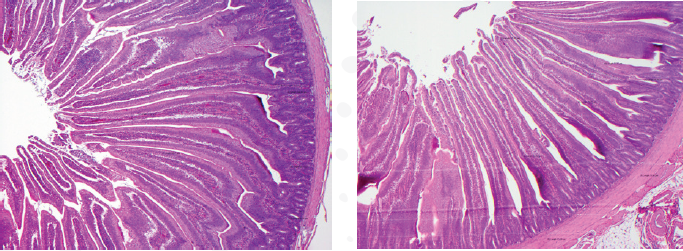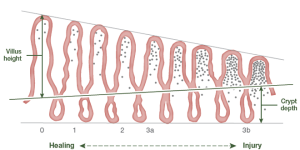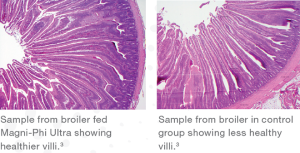Villi Length and Crypt Depth: The Measurement of Poultry Intestinal Health
How is intestinal health best measured? According to many poultry scientists, healthy intestines can be identified by villi length and crypt depth.

Improved nutrient absorption, better weight gain and feed conversion, and improved carcass yield — it’s the performance trifecta that poultry producers strive for, and it all begins with intestinal health.1 But how is intestinal health best measured? According to many poultry scientists, healthy intestines can be identified by villi length and crypt depth. Longer villi and shallower crypt depth have been shown to improve the uptake of nutrients that pass through the gastrointestinal tract.
“Villi length is important, and what you’re looking for are longer absorption areas to allow nutrients to go through and get absorbed effectively,” says Dr. Luis Gomez, Senior Director of Global Poultry Technical Services, Phibro Animal Health Corporation. “These villi resemble fingers — and the longer the fingers are, the more cells they’re going to have available to absorb nutrients.”
Longer villi are typically indicative of healthier birds with better gut health. For chickens, the healthier the gut, the more efficiently the birds will grow.
Figure 1. Villi Marsh Classification2
“If the intestines aren’t healthy or the bird is fighting off a pathogen, those villi are going to be shorter and the absorption area is going to be reduced by 30% to 50%,” warns Dr. Gomez. “This means the bird is going to be less efficient at taking up crucial proteins, fats, minerals, or vitamins, making it more difficult to grow or carry out daily physiological processes and functions. That’s why villi length is so important.”
Intestinal Health Benefits at Half the Feeding Rate
Phibro Animal Health Corporation recently introduced Magni-Phi Ultra nutritional specialty product, the next evolution of the proven and effective Magni-Phi formulation producers know — now in a concentrated form at half the feeding rate. This formulation continues to deliver on the intestinal health benefits that producers are looking for, and it may ultimately translate to improved return on investment.
In recent studies, birds fed Magni-Phi Ultra were shown to have increased villi length and shallower crypt depth than those in control groups, as illustrated in morphologic imaging of poultry intestines.3
Figure 2. Morphologic Imaging of Poultry Intestines Shows the Effectiveness of Magni-Phi Ultra
“The morphologic images of poultry intestines really speak to the effectiveness of Magni-Phi Ultra,” says Dr. Gomez. “I’ve conducted a number of morphometric studies where Magni-Phi products were fed, and the response is always the same — longer villi.”
“Morphometrics of the intestinal tract in poultry has been around for a long time, yet it’s not a part of routine evaluations of intestinal integrity,” he says. “We know that a healthy intestine is the cornerstone of poultry health, and we’ll continue to conduct more research to show producers the effect of Magni-Phi Ultra on intestinal health, which can lead to improved body weight and feed conversion ratio, among other metrics. It’s part of our commitment to provide poultry producers the most effective tools to manage gut health.”
Magni-Phi Ultra is 100% natural and safe. It features concentrations of OMRI Listed® yucca and quillaja species that are safe for use in any production system, including birds vaccinated for Salmonella and coccidiosis.
To learn more about Magni-Phi Ultra, contact your Phibro poultry advisor or visit pahc.com/magniphi.
1. Bafundo, K. W., K. Männer and I. Duerr. 2021. The combination of quillaja and yucca saponins in broilers: Effects on performance, nutrient digestibility and ileal morphometrics. Br. Poult. Sci. 62(4):589-595.
2. Adapted from Hoerr, F. J. 2013. Assessing gut health with histopathology. Multi-State Poultry Feeding and Nutrition Conference Indianapolis, Indiana. May 22, 2013.
3. Gomez, L., et al. Intestinal Morphometrics — Is it the right tool to objectively measure intestinal health? Poster presented in the AVMA/AAAP 2021 Annual Virtual Meeting.
MP1180722GLB MP ©2023 Phibro Animal Health Corporation. Phibro, Phibro logo design, Healthy Animals. Healthy Food. Healthy World. and Magni-Phi are trademarks owned by or licensed to Phibro Animal Health Corporation or its affiliates. OMRI Listed® is a registered trademark of OMRI.







